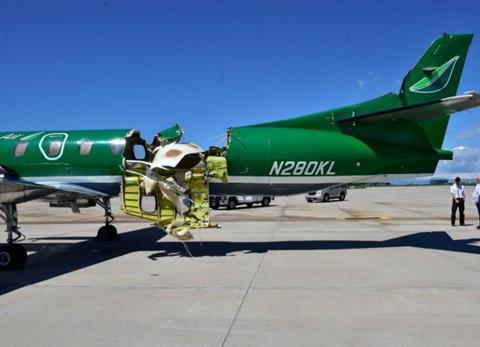US investigators have determined that a Cirrus SR22 pilot’s high speed while turning from base leg to final caused the aircraft to overshoot the centreline and stray into a parallel approach path, where it collided with a Swearingen Metroliner.
Both aircraft, which were communicating on different tower frequencies, were substantially damaged during the 12 May 2021 accident at Centennial airport in Colorado.
But the Metroliner, with just a pilot on board, managed to land safely while the pilot and passenger of the Cirrus – which deployed its recovery parachute – also survived.
Centennial airport’s parallel runways, 17R and 17L, were being used simultaneously. The Metroliner had aligned for final approach to 17L while the Cirrus was flying downwind on a right-hand traffic pattern for 17R, preparing to turn right for the base leg.
While the recommended flaps-up approach speed for the Cirrus was about 90-95kt, analysis shows the aircraft – which was under manual control – flew the base leg at about 148kt and was still travelling at 140kt as it attempted to turn onto final approach.

Halfway through the turn to final, still on a heading of 146°, the Cirrus struck the Metroliner some 3.2nm north of the airport and about 735ft above ground, tearing a large section out of the upper aft fuselage. Despite the damage, the Key Lime Air aircraft, which was being positioned from Salida, landed without further incident.
In a statement to investigators the Metroliner pilot said he heard a “tremendous explosion” and initially checked the engine controls, believing one of the two powerplants had failed.
The Cirrus was uncontrollable and, having activated the parachute system, came down about 3nm north of the airport.
Good weather conditions prevailed at the time of the collision, which occurred in daylight.

According to the US National Transportation Safety Board, the Cirrus pilot’s decision to fly faster than the recommended approach speed resulted in a larger turn radius and overshoot of the 17R approach.
The aircraft strayed into the 17L approach path and its trajectory “would have taken it even further left of the final approach course for [17L]” had it not collided with the Metroliner, says the inquiry.
But the investigation also states that the two aircraft were communicating with two different tower controllers, on two different radio frequencies, while inbound to the airport.
Although the controller handling the Cirrus had cleared it to land on 17R, and issued traffic advisories to the pilot, the controller of the Metroliner – which also had landing clearance – did not give its pilot an advisory regarding the location of the Cirrus.
“Had the controller issued an advisory, the pilot of the [Metroliner] may have been able to identify the conflict and manoeuvre his airplane to avoid the collision,” says the inquiry.
Both the Metroliner and Cirrus pilots had each been advised of the presence of another aircraft, a Cessna, which had been in the airport’s traffic pattern for 17R ahead of the Cirrus. The inquiry also found that the Cirrus’s avionics system issued a traffic alert which remained on until the collision 36s later.


























